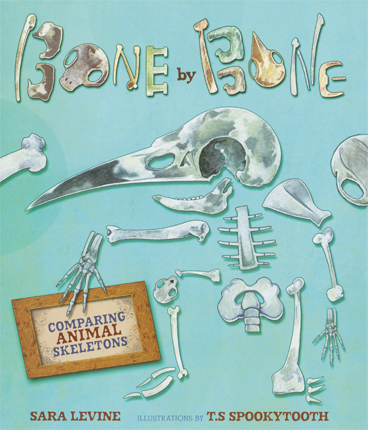Full Text Reviews: School Library Journal - 09/01/2013 K-Gr 2—Levine takes a unique approach to comparative anatomy. The purpose of the book is to illustrate differences between human and animal bone structures. Each page presents a question, e.g., "What kind of animal would you be if your finger bones grew so long that they reached your feet?" The answer is revealed with the turn of the page ("A bat!"). The bright, stylized, color illustrations match each question, portraying cartoon children with distorted anatomy, such as a girl with a neck like a giraffe's, or a snake with a human head. Some may find the gloppy piles of cartoon children with no bones unappetizing, while others may find the peculiar images amusing. Many of the riddlelike questions will play well in a storytime setting, allowing readers to ask a question and permitting children to imagine and participate in the answer. Bone by Bone does not have the detailed informational content or illustrative depth of Steve Parker's Skeleton (DK, 1988), but it does succeed in presenting basic structural differences among animals. This unusual book is interactive and thought-provoking, if a little gross in certain sections.—Jeffrey Meyer, Mount Pleasant Public Library, IA - Copyright 2013 Publishers Weekly, Library Journal and/or School Library Journal used with permission. Booklist - 10/15/2013 Alongside an illustration of skin collected in goopy puddles upon the sidewalk, the author asks, “Have you ever wondered what we would look like if we didn’t have any bones?” Children will enjoy the humorous illustrations and labeled diagrams as they predict the morphing of a human skeleton, Dr. Moreau–style, into that of various animals. By adding vertebrae to a boy’s back—presto!—he has a tail. And by removing leg and arm bones, just like that he becomes a snake. The author makes a careful distinction between vertebrate and vertebrae, but adults will likely have to make further explanations to younger children. Then, with the question, “Could you be an animal if you didn’t have any bones at all?” the book switches briefly to invertebrates. With its wild, inventive, and occasionally alarming animal-human mash-ups, this works as a lighter companion to Steve Jenkins’ Bones: Skeletons and How They Work (2010). - Copyright 2013 Booklist. Loading...
|



